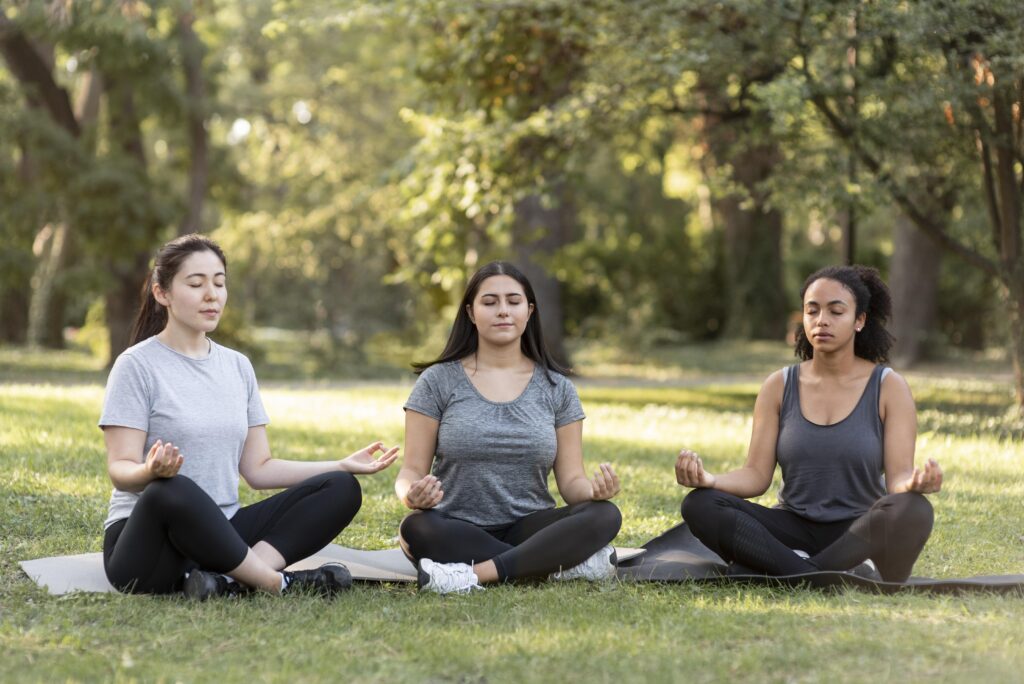
Yoga is popular right now. Everyone is eager to practice yoga. A lot of individuals believed that there was no distinction between meditation and yoga. I would like to clarify how and what the differences are between yoga and meditation for those who are new to it or lack knowledge.
What is YOGA?
Yoga is a style of life that strives to achieve the ultimate spiritual objective, known as “Samadhi,” which is self-realization or union with higher awareness, by eliminating suffering and barriers from existence. Yoga comprises several paths and practices that aid in reaching the intended outcomes.
The commercial fitness industry’s attempt to utilize yoga as a gimmick for sales and materialistic advantages is regrettable. Yoga is more than just stretching as a supplement to strenuous workouts. But yoga is much more than that; it’s a way of life. It takes a comprehensive approach to living well. Mind, body, and spirit can all be connected through yoga. It also enhances day-to-day lifestyle choices.
Enhances interpersonal relationships and balances all bodily systems, including the respiratory, digestive, excretory, hormonal, and circulatory systems. Yoga promotes mental, emotional, and peaceful awareness.
Yoga raises immunity, enhances posture, enhances daily exercise regimens, and dramatically increases energy levels. It is quickly taking the lead as the preferred technique for everyday stress relief and successful weight loss. Many forms of yoga are practised by people all over the world, including Jnana yoga, Hatha yoga, Raja yoga, Bhakti yoga, Mantra yoga, and classical or Ashtanga yoga, among many other variations.
When it comes to teaching and training Ashtanga, or classical yoga, The Yoga Institute is a trailblazer. There are eight limbs in traditional yoga. The first four are named Yama, Niyama, Asanas, and Pranayama (also known as Bhairanga Yoga or external yoga). The fifth limb, Pratyahara, is said to represent the link between external and internal yoga, Antaranga Yoga and external yoga.
The three pillars of Antaranga Yoga are Samadhi, Dhyana, and Dharana. The five Niyamas govern social behaviour, and the five Yamas serve as rules for one’s behaviour. yoga poses for increased physical strength, flexibility, and endurance; pranayama for emotional and mental stability; and pratyahara for sensual restraint Dharana denotes focus, whereas Dhyana, the ultimate aim of yoga, denotes meditation.
When one masters meditation, one can reach samadhi, a state of acute focus. Samadhi is considered the pinnacle, the point at which one achieves unity with the divine or a higher reality.
Ashtanga or classical yoga is recommended for novices, intermediate students, and regular householders in the ancient Patanjali Yoga Sutra. However, it is strongly advised that you learn how to do yoga from certified and experienced yoga instructors before you begin. Classical yoga is a good choice for those who want to maintain good mental, physical, and spiritual health as well as enhance their behaviour. Yoga has numerous holistic advantages.
What does MEDITATION mean then?
Our lives are hectic these days, filled with a ton of duties, obligations, stress, and unfounded anxieties. The way we think and the things we usually do during the day differ pretty much greatly. However, when your thoughts and deeds are exactly in sync, you experience no tension or conflict and are truly focused at that one moment. You have decided to live in the now. You also typically experience less fatigue and greater delight.
There are no physical exercises or movements involved in meditation practice. An individual attempts to concentrate their bodily energy on a specific object, sound, breath, etc. while sitting in a designated spot. In essence, yoga is a practice that includes meditation, which is typically done after asana. Following a yoga asana session, meditation is recommended to achieve a stable state for both the mind and body since afterwards, the body is full of vibrations. Through controlling respiratory regulation and reducing overthinking, meditation improves self-realization and overall well-being. In contrast to meditation, There are several clear limitations to practising yoga, such as the need to practice certain poses on an empty stomach or avoid doing certain poses if you are ill or experiencing other health problems.
Yoga meditation is a profound condition of union with the object of contemplation; it is not about thinking. Regular meditation practice involves maintaining a sharp focus on a single object, sound, visualization, breath, or a deep awareness of the present moment. This practice reduces tension and anxiety, stops overthinking, and encourages relaxation. Thus regular meditation practice develops the capacity to find this kind of attention. This calls for work, and the basis of Dharna, or brief meditation on a single topic, is the capacity to direct the mind’s attention to that one thing. If the student is to go to the challenging stage of Samadhi, or liberation, this is a must. So let’s use a straightforward illustration to comprehend the distinction between Akshara and Rudra.
Imagine a closed tap with dripping water coming from it. Akshara is comparable to focused attention on a specific item for a brief period, such as the movement of water droplets.
Conversely, if you pour honey straight from the jar, the stream remains uninterrupted; this is comparable to Rudra, which is a prolonged, fully focused meditation.
According to the ancient teachings, Samadhi occurs when a Yogi can maintain Rudra for a long time. During this time, the consciousness level is elevated and cleansed to the point that the soul resembles a transparent jewel that combines with the greater reality on all planes. It’s a condition that’s hard to describe with words. There are very few people that achieve the Samadhi state and it is an extremely unusual occurrence.
For comprehensive health advantages, yoga and meditation should be practised in tandem; however, be sure that both are done under the supervision of a qualified yoga teacher. Now that the distinction between meditation and yoga is evident.